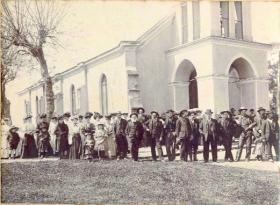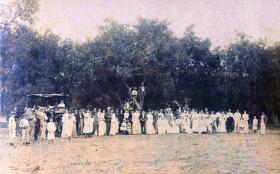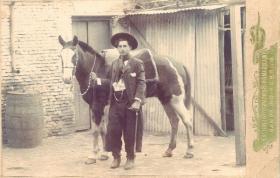The Irish ‘Ingleses’ in nineteenth-century Buenos Aires
Published in 18th–19th - Century History, 20th-century / Contemporary History, Features, Issue 4 (Jul/Aug 2008), Volume 16
St Patrick’s old chapel in Santa Lucía, c. 1890. The men to the right include prominent local landowners, among them the local Irish chaplain, Fr Edmund Flannery (also a landowner). (Centro Argentino Irlandés de San Pedro).
British identity and citizenship were of great importance to the nucleus of British and Irish residents in the city of Buenos Aires during the nineteenth century. This variety of British subjectship was an identity that many in Ireland were domestically uncomfortable with yet appropriated for economic and social advantage in Argentina.
Part of the informal British Empire
The significance of British identity to the subset of Irish immigrants was crucial; Catholic British subjects were at one and the same time part of the informal British Empire and Latin loyalists. Buenos Aires was not part of the British Empire, yet British presence and influence in the city and province were strong enough that British subjects could conduct business and migrate there as if it was. Therefore, even in the Argentine case, Irish immigration was contingent on overseas British commercial and political activity. The British transatlantic merchant network, and access to it, shaped the destinies of the Irish immigrants who made the move to Argentina from the 1830s.
The Spanish Empire in America was conducive to successful business dealings for British citizens. The formal, legal impediments that did exist lessened significantly with the coming of independence in the River Plate region in the 1810s. Immigrants with Irish, British and Spanish familial ties were at a significant advantage. These residents could use their European networks and commercial contacts to their social and financial advantage and avail of their linguistic capabilities to further themselves, performing a delicate balancing act between the advantages of Spanish, and later Argentine, identity or citizenship and the retention of British credentials. Throughout the nineteenth century, British subjects and children born in Argentina of British parents could choose between adopting British or Argentine citizenship.
Central to an understanding of Irish dual, if not multiple, identity in Buenos Aires is the fact that in nineteenth-century Spanish-language literature on immigrants in Argentina Irish people are almost exclusively referred to as ingleses, ‘English’. This was an umbrella term for all English-speakers; few, if any, of the Irish community spoke Irish as a first language, and the people of Buenos Aires were unlikely to distinguish between different ethnic groups of Anglophones.

An Irish gathering at San Pedro, Buenos Aires province, c. 1906. Families and young people organised such picnics and musical reunions in the countryside, including dancing, guitar- and fiddle-playing and open-air games. Note the cook holding barbecued lambs aloft to the right of the picture. (Centro Argentino Irlandés de San Pedro).
Conflicting values
Their composite Irish–British identity eventually led to conflicting values among the Irish-Argentine community, which could only be reconciled either by the intensification of their British identity, and of all the advantages that this brought with it, or by presenting themselves as oppressed Catholic Irish.
Many members of the late nineteenth-century rural Irish immigrant community that developed from the British merchant infiltration of Buenos Aires made much of their distinct Irish, and later nationalist, identity. Many twentieth-century writers are wont to superimpose a nationalist Irish identity on Irish immigrants in Argentina, whereas in fact regional fealties were more potent for the immigrants at this time. On an international level, some immigrants to Buenos Aires and elsewhere were more likely, for both pragmatic and emotional reasons, to identify themselves as British rather than Irish. In the 1830s and 1840s, we should not consider the immigrants’ Irish and English identities as mutually exclusive but rather as elements in a composite identity, which distinguished these migrants by their English–Irish–Argentine culture.
When Catholic Emancipation was achieved in 1829, John Thomond O’Brien, an Irish general who had collected funds to promote emancipation among the British of Buenos Aires, affirmed that the newly politicised Irish of that city were ‘the firmest supporters of the glory of the British Empire’. As Ireland was part of the United Kingdom of Great Britain and Ireland throughout the nineteenth century, Irish people, and especially the Anglophone Irish, which included almost all of the immigrants in Argentina, identified themselves as British while retaining a sense of community with Irish immigrants.
Early Irish migrants to Buenos Aires—those who were, on average, the most successful at making money and intermarrying with the Creole élite—also tended to be politically pro-Union loyalists. They later formed a substratum of the Irish community, and could be roughly identified as those who read the Standard newspaper rather than the nationalist-leaning Southern Cross. British-Irish immigrants with a certain amount of capital at their disposal and a good reputation could insert themselves easily into a merchant upper middle class. Irish sheep-farmers had close business relations with English wool-brokers, and later in the century Irish farmers exported wheat to the English market. During the second quarter of the nineteenth century, many Irish families flew the British flag above their homes in the countryside, which afforded them the protection of the British chargé d’affaires.
When money was to be made in the countryside, immigrants joined fellow Irish people in buying land, avoiding military service as British immigrants and being afforded protection by the governor, who declared security for all ingleses. Irish people, however, had the advantage that when Britain was considered the enemy they could also speak out against the imperial power, thus remaining always on good terms with the government.
Primarily because they were Anglophone, the Irish, like the Scots, were termed ingleses by the people of Buenos Aires. As a gaucho character in William Bulfin’s fictional The fall of Don José explained, ‘In the camp, any man who speaks English is an Inglés. We gauchos are not fond of fine distinctions in reference to any folks but our own.’ This granted Irish immigrants a higher social status because of their perceived ‘civilisation’ in a society striving to absorb influences from England. In his analysis of four sets of Irish migrants’ correspondence in Buenos Aires, Edmundo Murray found remarkably few references to the oppositions that are characteristic of the historiography on the relationship between the British and Ireland.

Irish-Argentinian Thomas Young in his ‘gaucho’ Sunday best c. 1930s. Over time, descendants of the Irish came to perceive themselves as Argentinians. (Centro Argentino Irlandés de San Pedro)
‘Soy inglés’
The Southern Cross newspaper in 1876 complained that Irish immigrants themselves repeatedly identified themselves by saying ‘Soy inglés’ (‘I am English’). Though the newspaper lamented what it perceived as a loss of nationality, the writer went to some lengths to appease its English readers:
‘In no other part of the world save in South America have we lost our nationality, that nationality eminently Irish, and of which our country men all over the globe are so jealous and proud . . . We believe the English to be a fine, noble people; we are glad to have them as fellow subjects, but we despise the Irishman who so far forgets himself as to allow his nationality to be merged completely with the English.’
The English language was associated with the upper classes in Buenos Aires province, owing to the dominance of British merchants in trade, commerce and particularly railways. Railway companies in Argentina were almost exclusively British and preferred to employ English-speakers. Thus the Irish immigrants, intent on conserving the use of that language among their community, contributed to the spread of English in the province. The establishment of English-speaking Irish schools was favoured by the government, and in many cases it was not exclusively Irish immigrants and their descendants who attended them, but also the offspring of Creole families who wanted their children to be successful in the business sphere.
Catholicism an advantage
The fact that the Irish ingleses were mostly Catholics, while retaining a British identity, made them more desirable to the Catholic government. It was convenient for the British Empire to place British Catholic subjects in a Catholic commercial town within their ‘informal empire’. Directing trade to the advantage of the British Atlantic trade system, they were more likely to be accepted by the general populace as co-religionists. Therefore the very Catholic identity that had disadvantaged the migrants in Ireland became a crucial advantage on crossing the Atlantic.
There were some signs of disharmony between British and Irish immigrants in Buenos Aires. A squabble occurred over Green and Bell’s British Subjects’ Fever Fund, as the Irish community was worried that Irish fever victims had not been included. The separate Irish and British hospitals are a case in point. There were moves to unite them between 1848 and 1880, indicating that many involved in both did not see a reason for their separate existence, but they did not bear fruit and the two communities continued to receive separate healthcare. Nevertheless, in the 1860s as many as 60 per cent of the British Hospital’s free patients were Irish, yet the Irish community preferred to give financial support to the Irish Sisters of Mercy Hospital. Some Irish immigrants donated money to the British Hospital, ‘contributing to it as liberally as if it were a Repeal Club!’ (The Standard, 28 May 1862).
The English and Irish communities very often worked together for mutual benefit, free of the animosities that would develop later and which cannot be assumed retrospectively for this time. For example, during harvest time on the Pampas, Irish and English people often helped each other. Jane Robson, a Scottish immigrant, related the story of an Irishman becoming embroiled in a knife fight with some Creoles at horse races on St Patrick’s Day. She called out to the English people in the vicinity, ‘Are you going to see your countryman butchered?’ and they came to his aid.
Growing Irish antagonism towards British rule
On St George’s Day 1835, the English community of the city of Buenos Aires toasted ‘the Rose, the Thistle and the Shamrock, their Union, and equal rights to all’. Similarly, a quarter of a century later, on St Patrick’s Day 1861, the Irish community in Buenos Aires toasted ‘the queen, the pope and the Irish parliament’. By the 1880s, however, developments in Ireland were having an impact on the Irish community in Buenos Aires, and particularly on the British minister’s perception of growing Irish antagonism towards British rule. When Patrick Dillon, dean of the Catholic cathedral in Buenos Aires and a provincial legislator, was entrusted with travelling to Ireland to promote emigration to Argentina by the Argentine government in 1881, he met with the British minister to discuss the plans. According to Dillon, ‘there was a strong feeling of distrust of the British government and of its agents among the class he was going to’.
Within the British community of Buenos Aires, the Irish contingent was ethnically the largest, and was assuming various roles in order to maximise its opportunities for success and prosperity. When compared to domestic events in Ireland and Britain, the apparent anomaly of Irish Catholics collaborating with British colonial interests throws light on the complexities of migrant identity. A more nuanced picture of Catholics, sometimes ‘British Catholics’, from Ireland working within the international economic framework of the British Empire emerges. This throws into question a purely nationalist interpretation of Irish emigration historiography, showing it to be oversimplified and masking a more complicated web of identities.
Claire Healy is an Advisor at the Office for Studies and International Relations of the High Commission for Immigration
and Intercultural Dialogue in Lisbon.
Further reading:
A. Graham-Yooll, The forgotten colony: a history of the English-speaking communities in Argentina (Buenos Aires, 1999).
O. Marshall (ed.), English-speaking communities in Latin America (New York, 2000).
E. Murray, Becoming Irlandés: private narratives of the Irish emigration to Argentina, 1844–1912 (Buenos Aires, 2005).


















